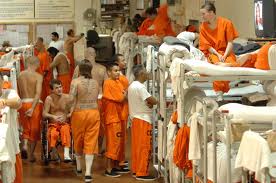By US Daily Review Staff.
An estimated 9.6 percent of adult former state prisoners reported being sexually victimized during their most recent period of confinement, the Justice Department’s Bureau of Justice Statistics (BJS) announced today. About 7.5 percent alleged that they were victimized while in a state prison, 1.8 percent while in a local jail, and 0.1 percent while in a post-release community treatment facility.
 An estimated 3.7 percent of former prisoners said they were forced or pressured to have nonconsensual sex with another inmate that included manual stimulation and oral, anal, or vaginal penetration. About 5.3 percent reported an incident that involved facility staff.
An estimated 3.7 percent of former prisoners said they were forced or pressured to have nonconsensual sex with another inmate that included manual stimulation and oral, anal, or vaginal penetration. About 5.3 percent reported an incident that involved facility staff.
These findings are based on the first-ever National Former Prisoners Survey (NFPS), a part of BJS’s National Prison Rape Statistics Program which has collected corrections administrative records of reported sexual violence or allegations of sexual victimization directly from victims since 2004. The NFPS is representative of 510,800 former state prisoners who were under active parole supervision at midyear 2008.
The victimization rate reported by former state prisoners is more than double the 4.4 percent reported in the most recent BJS National Inmate Survey (NIS, 2008-09) of confined state and federal inmates. The difference may reflect longer exposure periods for former state prisoners compared to persons still in state prison.
For example, former state prisoners described experiences that occurred during an average confinement of about 40 months, and reported incidents in multiple facilities, including jails, prisons, and halfway houses. In contrast, participants in the previous NIS described their experiences while in a single prison facility during an average confinement of 7.9 months.
The nature and pattern of sexual victimization observed in the former prisoner survey are similar to those found in the previous NIS, 2008-09.
Among former state prisoners, the rate of inmate-on-inmate sexual victimization was at least three times higher for females (13.7 percent) than males (4.2 percent).
Homosexual and bisexual male former prisoners reported high rates of victimization by other inmates. Thirty-nine percent of homosexual or gay males and 34 percent of bisexual males reported inmate-on-inmate victimization, compared to 3.5 percent of heterosexual males.
The rate of inmate-on-inmate sexual victimization for males was higher among inmates of two or more races (9.5 percent) and white non-Hispanic inmates (5.9 percent) than black non-Hispanic inmates (2.9 percent) and Hispanic inmates (2.7 percent).
Rates of staff sexual misconduct were higher for male inmates of two or more races (11.3 percent) and black non-Hispanic inmates (6.5 percent) than for white non-Hispanic inmates (4.5 percent) and Hispanic inmates (4.0 percent).
Among all victims of inmate-on-inmate sexual violence, a quarter said they had been physically held down or restrained and a quarter had been physically harmed or injured. About 29 percent of all victims reported bruises, black eyes, sprains, cuts, scratches, swelling, or welts from one or more incidents involving another inmate. Nearly a quarter (23 percent) also reported more serious injuries, including anal/vaginal tearing (12 percent), chipped or lost teeth (12 percent), being knocked unconscious (8 percent), internal injuries (6 percent), knife/stab wounds (4 percent) or broken bones (4 percent).
Although any sexual contact between staff and inmates is legally nonconsensual, former prisoners said some incidents were unwilling and some were “willing.” An estimated 1.2 percent of former state prisoners reported unwilling sex or sexual contact with facility staff, and 4.6 percent reported an incident that was “willing.”
The rate of “willing” sexual activity with staff was higher among males (4.8 percent) than females (2.6 percent). Also, females (2.5 percent) reported unwilling sexual activity with facility staff at more than twice the rate reported by males (1.1 percent).
Most victims of staff sexual misconduct reported some type of coercion. Half said they had been offered favors or special privileges and a third said they had been talked into it. Nearly 7 in 8 reported only perpetrators of the opposite sex. More than three-quarters of all reported staff sexual misconduct involved a male inmate with female staff.
The NFPS provides the first systematic data available on sexual victimization in community-based facilities. Among the estimated 65,500 former inmates who served time in a halfway house, residential treatment facility, or other pre-release center before their release from prison, two percent said they had been sexually victimized while in such a facility.
Rates of alleged sexual victimization did not vary among commonly cited characteristics of correctional facilities, such as the facility’s size or age, crowding, inmate-to-staff ratios, or gender composition of staff. Rather, victimization rates were higher for males in facilities under a court order, facilities that had reported a major disturbance in the 12 months prior to the most recent facility census, and facilities that housed general population.
Rates were lower for females in facilities that permitted 50 percent or more of their inmates to leave unaccompanied during the day. Rates for males and females were lower in minimum- or low-security facilities than in medium- or high-security facilities.
Following release from prison, 72 percent of victims of inmate-on-inmate sexual victimization said they felt shame or humiliation, and 56 percent said they felt guilt. Seventy-nine percent of unwilling victims of staff sexual misconduct said they felt shame or humiliation, and 72 percent said they felt guilt.
However, victims and non-victims did not differ in their current employment (64 percent employed) or housing arrangements (92 percent in a house, apartment, trailer or mobile home).
The report, Sexual Victimization Reported by Former State Prisoners, 2008 (NCJ 237363), was written by Allen J. Beck of BJS and Candace Johnson of NORC. The full text of the report, related documents and other BJS statistical resources can be found on the BJS website at http://www.bjs.gov/.

Average Rating